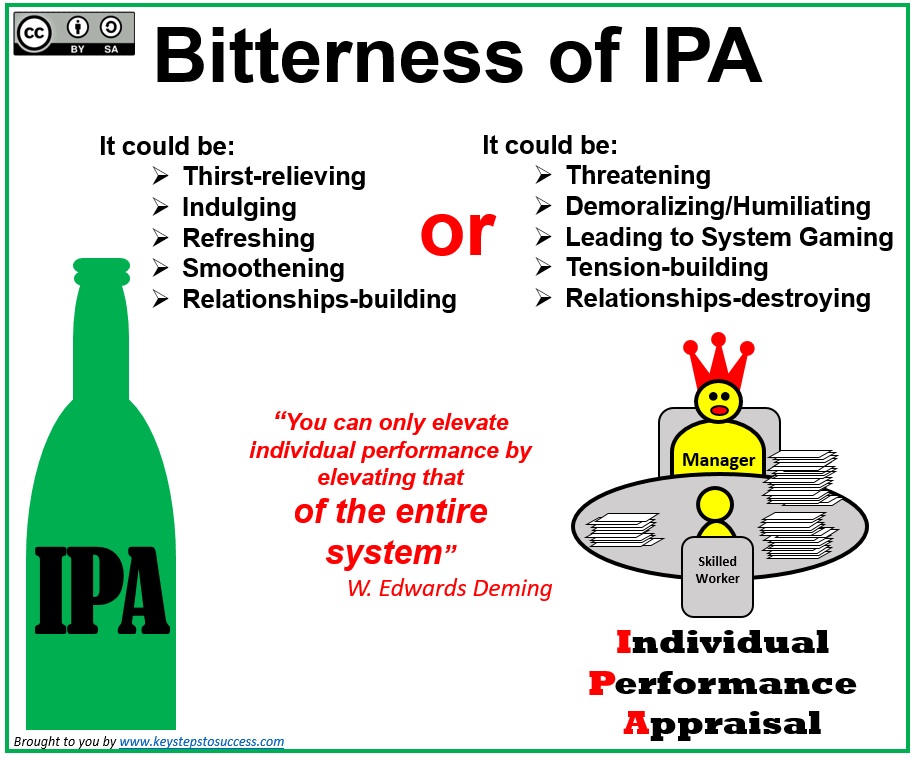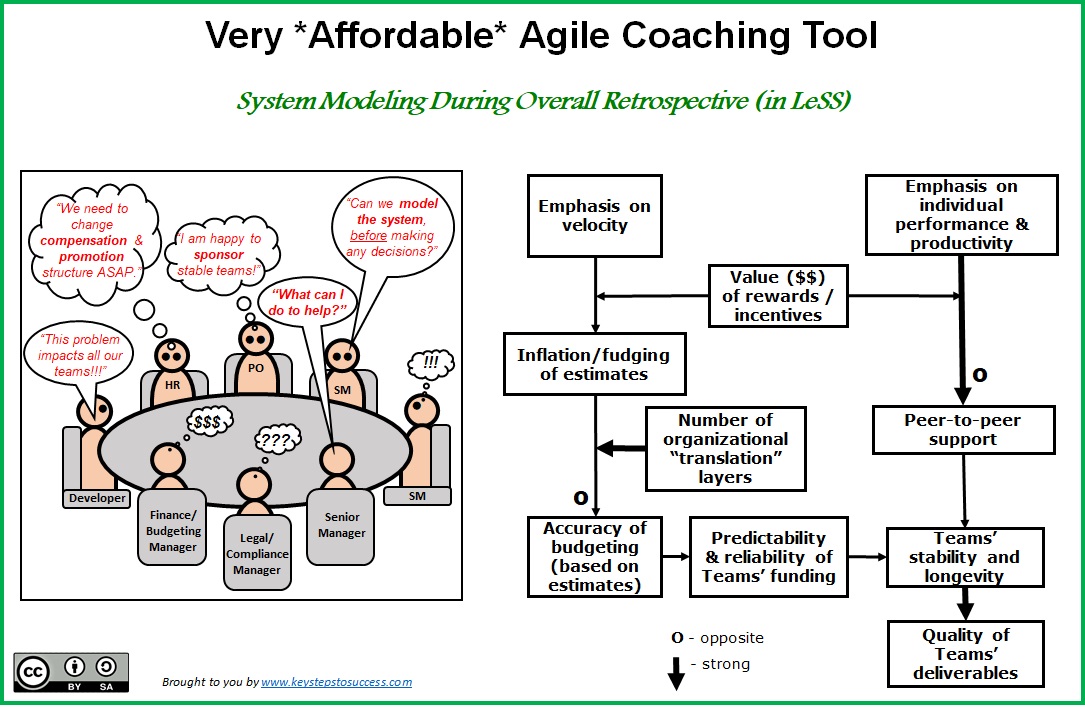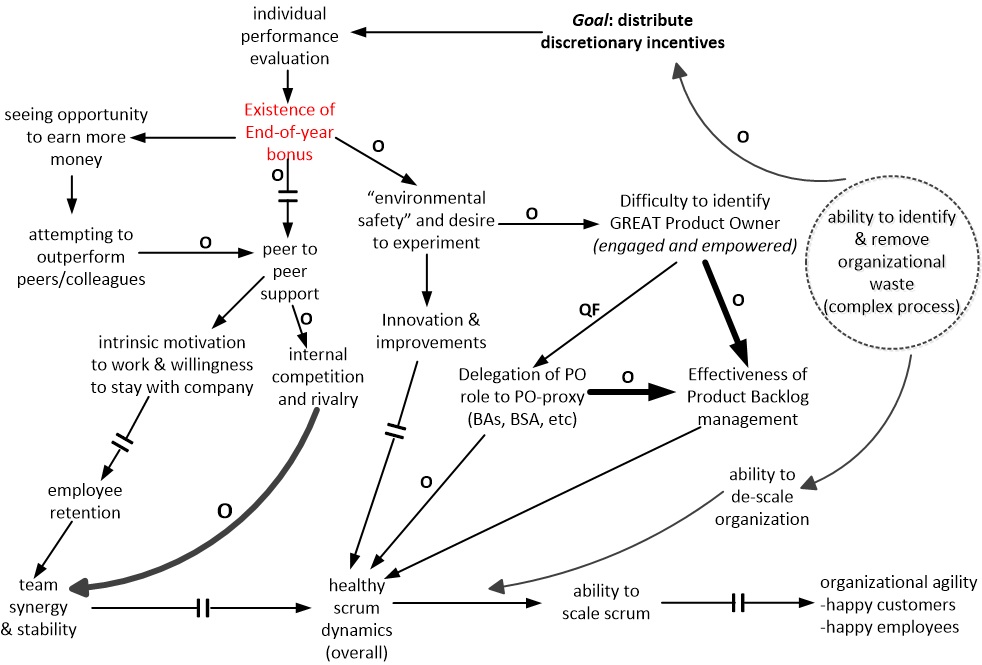“There is a mismatch between what science knows and what business does”
Psychologist Dan Pink
 |
 |
 |
 |
 |
 |
 |
 |
 |
For “Lazy/Busy” Readers (book excepts):
- Quotes from: “Get Rid of Performance Review!: How Companies Can Stop Intimidating, Start Managing-And Focus On What Really Matters”, by Culbert, Samuel A, & Laurence Rout
- Quotes from: “Punished by Rewards: The Trouble With Gold Starts, Incentive Plans, A’s Praise, and Other Bribes” by Alfie Cohn

System Model: Performance Appraisals VS. Team/Organizational Agility
Legend (How to Read Causal Loop Diagram)
- Variable – system elements that have effect/make influence on other system elements (other variables)
- Causal link – arrows that connect two related variables
- Opposite effect – “O” annotation near an arrow; suggest that effect of one variable on another variable is opposite to what could be expected
- Delayed effect – “||” annotation that disrupts a causal link (arrow); it implies that there is a delayed effect of one variable by another variable
- Extreme effect – one variable has an extreme (beyond normal) effect on another variable; it is represented by a thick arrow
- Constraint – “C” annotation near arrow; implies that there is a constraint on a variable
- Quick- Fix reaction – “QF” annotation near an arrow; action that brings about short-term, lower cost effect
Self – Assessment: Are Your Internal Policies Consistent With Organizational Goals?
- Does your company conduct performance evaluations/appraisals?
- Are performance evaluations/appraisals done on individuals (IPA) or teams (TPA)?
- What does your company stress more: individual or team delivery? What is counted more?
- How intense/time consuming is IPA/TPA management process for HR personnel?
- Is HR personnel of your company well informed of studies and research in the field of performance and motivation?
- Does your company explicitly recognize/promote the concept of the ‘team, as an organizational building block’?
- Does your company expect employees to share knowledge among each other?
- Does your company recognize individual contribution that cannot be measured directly, based on delivery?
- At your company, is becoming a manager (hands-off) perceived, as the main way to secure higher compensation/promotion?
- At your company, can an employee remain, as a hands-on expert, while receiving manager-level compensation?
- Does your company pay bonuses?
- To what extent is your company’s overall financial performance is factored in defining bonuses?
- For IPAs:
- How frequently does an employee get feedback on his/her performance throughout a year?
- How does your company collect feedback on an employee: openly or confidentially?
- Who is in charge of evaluating individual performance (e.g. manager, peers)?
- Is there a process in place for an employee to challenge IPA decision?
- Can an employee challenge a decision at any point in time, or just at a year-end?
- Is an employee required to manage his/her IPA in an internal system of record?
- How well the role of an evaluated employee understood by an evaluator?
- Is forced/stack-ranking (bell-shaped curve) used for a performance evaluation?
- Is compensation increase (base salary) tied to individual performance?
- Are bonuses paid as a lump-sum (once a year) or more frequently (throughout a year)?
- On average, what %-ge of a total compensation represented by a bonus?
- Does your company support the concept of “best employee of the month”?
- For TPAs:
- Does your company have an approach/method for how to reward teams?
- Does your company have an approach/method for how to reward individuals, based on teams’ rewards?
- Are bonuses tied to only individual, only team-based performance or mixed?
-
What Drives Human Performance? Did You reflect On This Internally, Within Your Organization?

Extended References: White Papers & Articles:
-
- Why good leaders make you feel safe?, by Simon Sinek
- Monetary Incentives linked to Appraisals (Systemic Implications Revealed), by Gene Gendel
- The Puzzle of Motivation, by Daniel Pink
- The Truth about Performance Reviews and Other Corporate Bullsh*t by Liz Ryan
- Why Your Best Employees Are Leaving For Your Competition, by Chad Halvorson
- You Could Lose Your Best Employees Because of These 7 HR Blunders, by Sujan Patel
- Performance Management for Agile People, by TechWell Contributor
- Rethinking the Review, by Julie Cook Ramirez
- Unjust Deserts?, by Mary Poppendieck
- Performance without Appraisal, by Esther Derby
- Unjust Deserts, by Mary Poppendieck
- How do we pay people in a LeSS adoption?, by Viktor Grgic
- Causal Loop Diagrams to Visualize System Dynamics, by Gene Gendel
-
Please, use the form below to submit your inquiry. If you are interested in training, coaching or consulting support, please provide, as much information as you can in the 'Message' field below:

